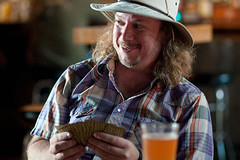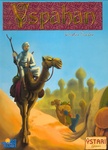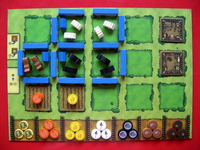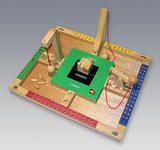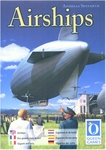This year, before going to the Westin DFW for 3 days of board games I also headed to Arlington for a my friend Rob’s birthday and played the weekend before. So, here’s my two long weekends of games:
Total Number of Games played: 51
Number of Different Games: 40
Number of New Games: 25
Ra – A classic Knizia bidding game that is out of print. TG has a large distaste for it, because of the bidding mechanism, but many people like this one a lot. I’m not a huge fan, but I’m always up for a game.
Vineta – The first time I’ve played this one. It came out last year. You secretly are responsible for one of the colors on the board. In the mean time, everyone is trying to flood parts of the city, and take the colored tokens that are theirs. Or preferable have them survive till the last part of the city is above water.
 Tichu (x 4) – Tichu is a 4-player, partner, trick-taking card game. It’s played with a standard deck plus four extra cards. I’ve become quite fond of it, and try to play whenever I can. I taught it to a few friends the first weekend, and played several games the second, once with two players that were much more experienced than I.
Tichu (x 4) – Tichu is a 4-player, partner, trick-taking card game. It’s played with a standard deck plus four extra cards. I’ve become quite fond of it, and try to play whenever I can. I taught it to a few friends the first weekend, and played several games the second, once with two players that were much more experienced than I.
Vegas Showdown – This is a great game to lure in the non-games, yet the gamers usually enjoy it as well. You are bidding on parts of a casino and each building your own better than the others.
Brass – This was a hot new game last year at BGG, and Austin friends Sharon and Adam brought it with them to Rob’s. Martin Wallace is known for meaty board game design. This was my first play and I liked it quite a bit. Managing goods and routes through a canal age and a railroad age.
 Carcassonne – A classic tile-laying game that is good as a gateway game. I recently introduced it to my nieces (13, 11, 8) and they all liked it. I like it for its flexibility. If you pick it up, grab the European scoring off The Geek.
Carcassonne – A classic tile-laying game that is good as a gateway game. I recently introduced it to my nieces (13, 11, 8) and they all liked it. I like it for its flexibility. If you pick it up, grab the European scoring off The Geek.
Dominion (x 4) – One of the biggest games of last year, it already has two expansions. Each game you work with only 10 of 25 sets of cards that make it extremely flexible. You build up a deck from almost nothing. This game has proven very accessible to mild gamers, it saw a lot of play the first weekend.
 The Downfall of Pompeii – This game has a great theme. First you are placing your people into the walled city of Pompeii, then Mount Vesuvius erupts and you try to get out, at the same time causing lava flows that kill your opponents.
The Downfall of Pompeii – This game has a great theme. First you are placing your people into the walled city of Pompeii, then Mount Vesuvius erupts and you try to get out, at the same time causing lava flows that kill your opponents.
Age of Gods – I’ve had this game for a while and not played it. It’s quite fiddly to set up, but plays quite easily. Likely targets teenage boys ideally. It was reasonably fun and short to play.
Portobello Market (x 2)– This is another game I’ve owned for quite some time but not played. It’s very short to play, and ultimately a multiplayer abstract with a glossy theme of setting up stalls at a market.
 Goldbraü (x 2) – Yet another game I’ve owned for a while and hadn’t played. And this one with a theme of controlling breweries and beer gardens. A stock ownership and area control combination. This one was released in 2004, maxes out at 4 players, and takes about an hour.
Goldbraü (x 2) – Yet another game I’ve owned for a while and hadn’t played. And this one with a theme of controlling breweries and beer gardens. A stock ownership and area control combination. This one was released in 2004, maxes out at 4 players, and takes about an hour.
Traders of Carthage – I bought this game from Z-Man on the last day of the Con last year. It is a 4-player card game with a small board. Shipping goods without being pirated. It does a great job of using the one deck of cards for multiple purposes throughout the game.
Lost Cities – A two-player card game, stereo-typed as “accessible to females”. It’s a good short game. Another Knizia. The 50th game to make it into the BoardGameGeek.com database, and ranked at 132.
 Glory to Rome – Another card game that plays like a board game. Also another game that puts the cards to different uses depending on how they are played in the game. I played a LOT of this game at Lone Star Con last NYE. It’s fun and quite variable. It does take a while to grok all the possible uses of the cards. The general theme is to build buildings in Rome, each giving you more abilities. We played this with west coast friends we met at the Con two years ago: Miguel and Paul.
Glory to Rome – Another card game that plays like a board game. Also another game that puts the cards to different uses depending on how they are played in the game. I played a LOT of this game at Lone Star Con last NYE. It’s fun and quite variable. It does take a while to grok all the possible uses of the cards. The general theme is to build buildings in Rome, each giving you more abilities. We played this with west coast friends we met at the Con two years ago: Miguel and Paul.
Power Struggle – This was a new Essen 2009 release this year and was in the Hot Games room. It was still opaque to me when I was finished – i’m not sure what kind of strategy to use in this one. I enjoyed it; it has an interesting interaction; and game/resource engine; but i’m still a bit apathetic towards it. I would certainly play it again to try to get a better feel. This was my first Thursday game.
 FITS – A 2009 Knizia release, this is a pattern filling abstract game, a wee tetris-like. Everyone plays independently, scoring against others. There was a lot of buzz on this one. I enjoyed it, but don’t feel it has a lot of replay for me. However it’s reasonably short, so I wouldn’t turn it down if someone wanted to play.
FITS – A 2009 Knizia release, this is a pattern filling abstract game, a wee tetris-like. Everyone plays independently, scoring against others. There was a lot of buzz on this one. I enjoyed it, but don’t feel it has a lot of replay for me. However it’s reasonably short, so I wouldn’t turn it down if someone wanted to play.
CirKis (x 2) – I was very excited to see this game. It’s a (Hasbro) block-laying game with similar design components as Blokus. The use of Penrose tiles is what so interested. I’ve always wanted to have a game (or design a game) that used this two shapes that tile the plane only asymmetrically. (Actually, one of my two unimplemented art car designs employs these shapes. If I ever pull the trigger on that one, it will have to have this game in it!) Our 3-player game was totally broken. I’m not sure if it was a game problem or a player problem. Likely some of both. The 4-person play was okay.
 Arimaa – This was the most mind challenging game of the weekend. It’s a two-player abstract that can be played with a chess board. It does however have its own game implementation if you want to buy a copy. 8 cats, 2 rabbits, 2 dogs, 2 horses, 1 camel, 1 elephant. All move the same: adjacent orthogonal. But you get 4 moves per turn and can push or pull weaker opponents. It was designed as a tougher computing problem than Chess. And it is.
Arimaa – This was the most mind challenging game of the weekend. It’s a two-player abstract that can be played with a chess board. It does however have its own game implementation if you want to buy a copy. 8 cats, 2 rabbits, 2 dogs, 2 horses, 1 camel, 1 elephant. All move the same: adjacent orthogonal. But you get 4 moves per turn and can push or pull weaker opponents. It was designed as a tougher computing problem than Chess. And it is.
Alhambra – There was a tournament, but I did poorly in the first round and was out. In this tile-laying game, you purchase different building types for your personal city on 4 different markets. This one’s been around since 2003.
 DiXit (x 2) – When I saw this game I knew I’d play it. The cards contain quite bizarre paintings. Considered a party game, you could also call it an “activity”, but there is scoring. Make up a sentence about your image, but not so close that you’ll have everyone guessing your vs. the ones everyone tossed in. A bit of a Apples to Apples feel, but for imaginative adults.
DiXit (x 2) – When I saw this game I knew I’d play it. The cards contain quite bizarre paintings. Considered a party game, you could also call it an “activity”, but there is scoring. Make up a sentence about your image, but not so close that you’ll have everyone guessing your vs. the ones everyone tossed in. A bit of a Apples to Apples feel, but for imaginative adults.
Eketorp – A viking themed game where you build a fortification while others try to knock it down. An interesting mechanism where a lost warrior goes to the “field hospital” and take a variable number of turns to return to your use depending on how poorly he lost. This game was released in 2002 and was in the library unpunched. I enjoyed it.
Nefertiti – An interesting auction game with several markets and different and changing bid mechanisms. I enjoyed it, but didn’t win it. I played this game (and many others) with some Jr High/High School friends Manuel and Kevin, as well as with TG. She didn’t mind the bidding mechanism on this one as much as Ra.
 BasketBoss – New from Essen this year, an amazingly light themed game with quite an interesting mechanism beneath. Managing a basketball team, buying player, bidding on support personnel (Trainer, Referee, Agent). Teams are ranked each season. This one seems very accessible to the non-gamer or new-gamer.
BasketBoss – New from Essen this year, an amazingly light themed game with quite an interesting mechanism beneath. Managing a basketball team, buying player, bidding on support personnel (Trainer, Referee, Agent). Teams are ranked each season. This one seems very accessible to the non-gamer or new-gamer.
You Robot – Seemed like it could be a good game, but as Peter put it “more frustrating than silly”, you attempt to get your partner to get into the position of the robot on the card using only three direction cards and pointing at them. It would play best if all the clue givers left the room, discussed the position, and if there was a judge in on it to confirm when positions were achieved and that players weren’t otherwise coaching. It might be fun with kids, supervised, with rules adjusted as needed.
 a la Carte – Listed as a 1989 design, was part of the class of 2009 at Essen. It was verging on Hit Game status at the Con. It’s hard not to be with it’s fun components. Some dexterity desirable, but dexterity isn’t necessary helpful. Making recipes, shaking the right amount of components out of the bottles they’re contained in: too much is bad. It’s definitely fun, and is a great family game.
a la Carte – Listed as a 1989 design, was part of the class of 2009 at Essen. It was verging on Hit Game status at the Con. It’s hard not to be with it’s fun components. Some dexterity desirable, but dexterity isn’t necessary helpful. Making recipes, shaking the right amount of components out of the bottles they’re contained in: too much is bad. It’s definitely fun, and is a great family game.
Agricola – Two years ago this was the huge game, but with 100s of cards, and a limited supply of German-only games available (and the required paste-up needed), I didn’t play it until last year. It’s a fun game, and once we got through the laborious setup I remembered why it was worth it. This was the game people went overboard on before they went overboard on Dominion.
 Twilight Struggle – I got this game as my free game after registration. Mark found out and had to play me (with the copy he brought). He’s a lover of the game, and I’d only played once before, so it didn’t last too long. This is a two-player card event-drive game, Cold War US v USSR. (A precursor to 1960: The Making of the President and Campaign Manager 2008)
Twilight Struggle – I got this game as my free game after registration. Mark found out and had to play me (with the copy he brought). He’s a lover of the game, and I’d only played once before, so it didn’t last too long. This is a two-player card event-drive game, Cold War US v USSR. (A precursor to 1960: The Making of the President and Campaign Manager 2008)
Cartegena – I picked this one, blind, off the library shelf. It is a simple racing game of getting your 6 pirates out of prison via a tunnel before anyone else. It’s simple and could be played with small children. We played it open handed and open draw pile to make it more strategic. There is one mechanic that could be considered broken, so the game was redesigned and re-released. So, I had to chase that one down in the library too. General consensus was that the first game with one tweak would have done the job.
Ubongo 3D – A 2-cube deep version of the 2-D original. A 2009 Essen game, it was entirely in German, so I’m not sure how the scoring works, but I came across a couple trying out the timing portion of the game. It was hard. Very hard.  Not sure how the game might be modified to handle that, not being able to read the rules.
Not sure how the game might be modified to handle that, not being able to read the rules.
Tumblin-Dice (x 2) – A classic. Play this every year. This is a must have for a game room, and would be an awesome bar game. Rolling dice down a cascade of increasing multiplyer levels without them falling off. If you’re an amateur wood worker you could definitely make your own.
Colonia – An Essen 2009 Hot Game that is pure Euro. A limited number of men to perform an action with, including: choosing first player, buying resources at market, generating goods from resources, shipping resources for money, buying relics (victory points) for money. With voting at three phases each turn.
Njet! – To me, nyet has always been spelled with a y, when not in Cyrillic. A trick-taking game that starts by determining how you’re not going to play. Who picks their partner? What’s trump? What’s super-trump? How many cards are discarded? What is the score for this hand multiplied by? It played okay with 3, but needs to have a fair number of hands to even out.
Cartegena II – I missed it in the library because the box doesn’t say “2” on most of the sides. The additional rules made quite a few modifications, mostly just making for more rules and not a better game. But, a different game.
 Snow Tails – A great theme and mechanism for a racing game, the strength of dogs on either side of your sled will cause it to slide one way or the other.
Snow Tails – A great theme and mechanism for a racing game, the strength of dogs on either side of your sled will cause it to slide one way or the other.
Game Show (Family Feud) – For the third time, we played the game show, which was very good this year and Family Feud Themed. TEAM AWESOME!!!!! came in third to last, but had a great time.
Nanuk – This is a 5-8 player game, and plays better the more players there are. I played it 8-player with one of the designers (Mark). It’s a good game for larger numbers and can be expanded in length and scored to be more equitable. The short version is almost random, and would certainly need experienced players to be fair. This was a new release just available.
Ubongo – Speed laying shapes. I don’t like the scoring track on this one at all. I dislike most games with speed elements.
Ubongo Extreme – This is done with multi-hex shapes rather than multi-square shapes. Much harder.
 duck! duck! SAFARI! – We were lucky enough to have the designer Kevin teach us this one late night on Saturday. There are 5 games within this one, and he suggested Hi-Lo Hijinks. I enjoyed it, though there was some initial confusion. Beer and wine were involved.
duck! duck! SAFARI! – We were lucky enough to have the designer Kevin teach us this one late night on Saturday. There are 5 games within this one, and he suggested Hi-Lo Hijinks. I enjoyed it, though there was some initial confusion. Beer and wine were involved.
Sorry! Sliders – Paul and I stayed up late and played all the variety of games this one provides. It’s basically a shuffleboard variant. This won best Family Game at the Con, and that’s easy to see. Kids like knocking stuff into other stuff, and so did we.
Robber Knights – I haven’t played this, yet, but got a free copy from Queen Games at the Con.
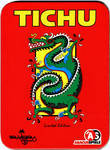 Tichu is actually a card game, and one I play quite often. I have the opportunity to play most Sundays at our friendly gathering at the local watering hole. We’ve infected about a dozen people with the game, and often will have 4 there to play. I also recently infected one of my weekly game attendees (who already liked Tichu) to come to our week end gathering.
Tichu is actually a card game, and one I play quite often. I have the opportunity to play most Sundays at our friendly gathering at the local watering hole. We’ve infected about a dozen people with the game, and often will have 4 there to play. I also recently infected one of my weekly game attendees (who already liked Tichu) to come to our week end gathering.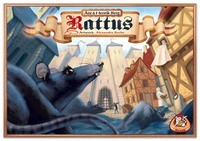 Rattus (2010, Henrik & Åse Berg) was one particular game on my list that I really wanted to try. A new Essen release, it was on a lot of people’s list, and was in and out of the library quite frequently. I got it once, read the rules, and was tugged into another game. To be polite I checked it back in while I was playing. I didn’t even get it back to the shelf before someone took it out of my hand to check it out again. I managed to get it again later in the week and teach it to some others.
Rattus (2010, Henrik & Åse Berg) was one particular game on my list that I really wanted to try. A new Essen release, it was on a lot of people’s list, and was in and out of the library quite frequently. I got it once, read the rules, and was tugged into another game. To be polite I checked it back in while I was playing. I didn’t even get it back to the shelf before someone took it out of my hand to check it out again. I managed to get it again later in the week and teach it to some others.